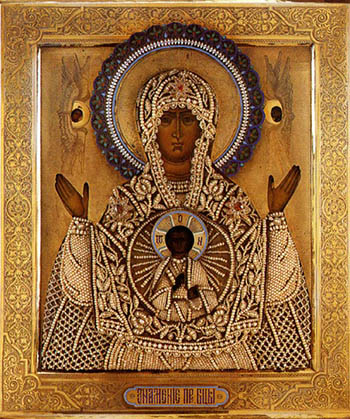
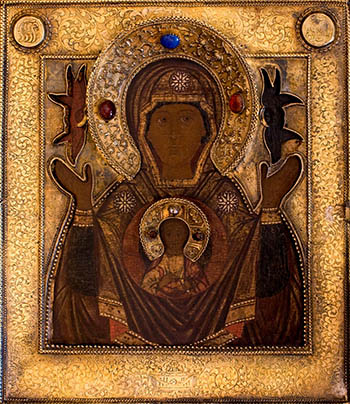
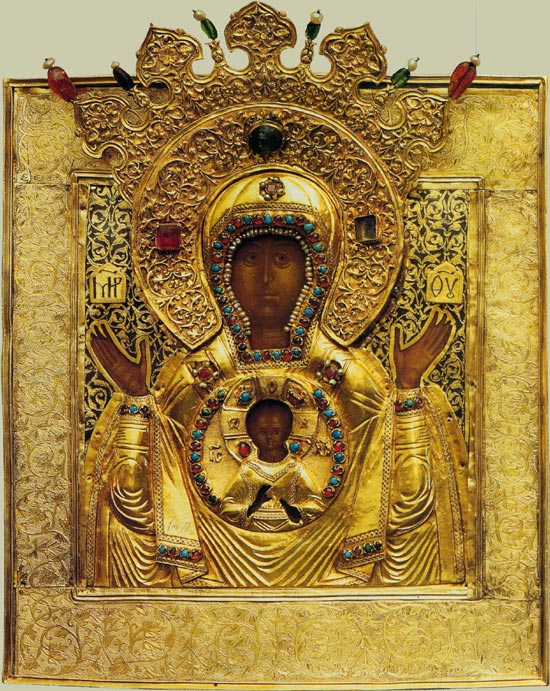
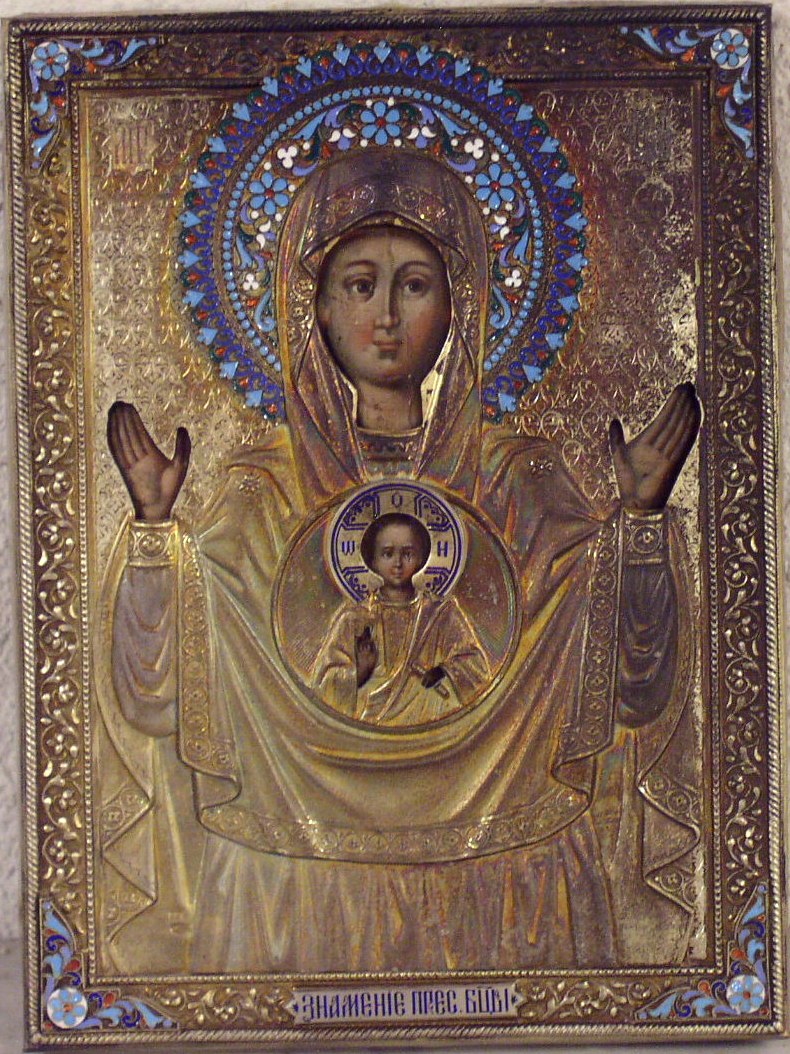
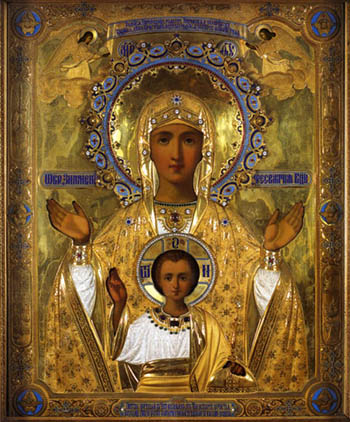
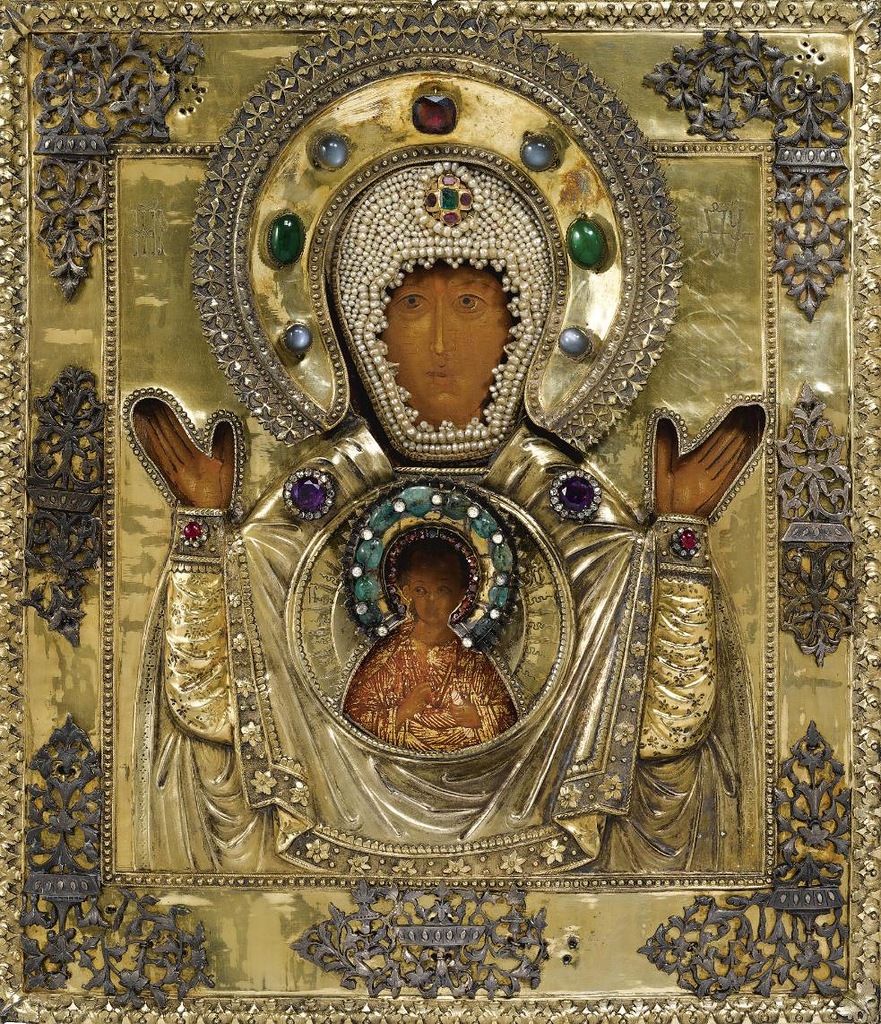
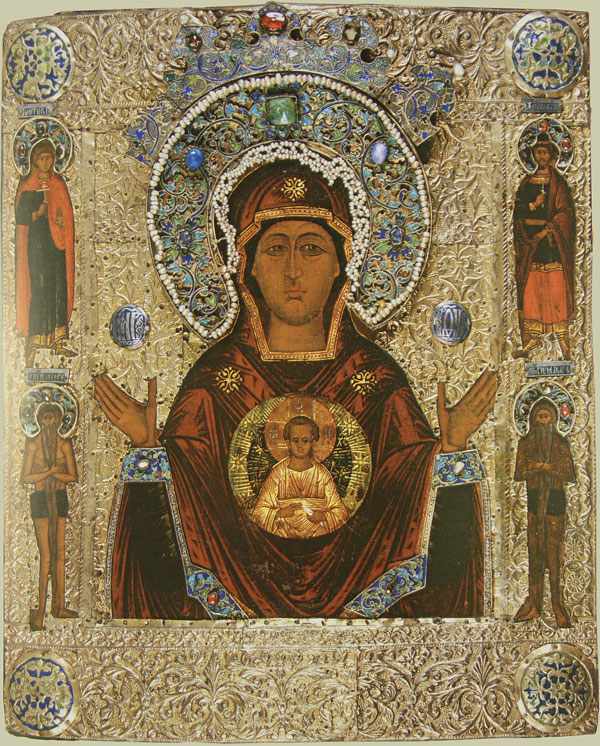
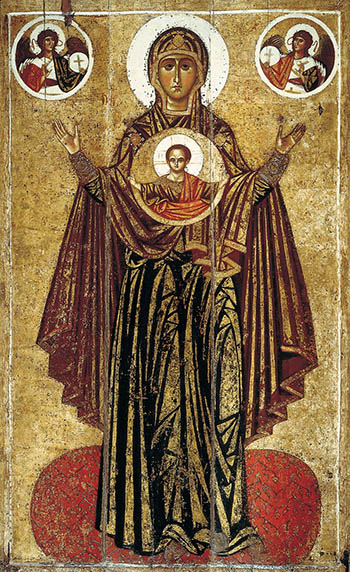
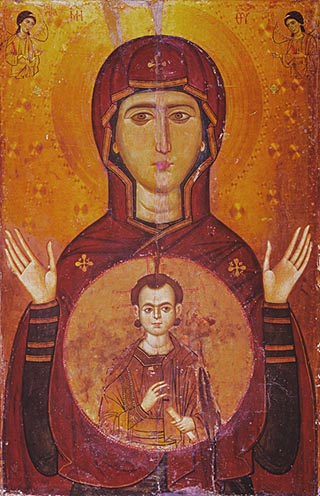
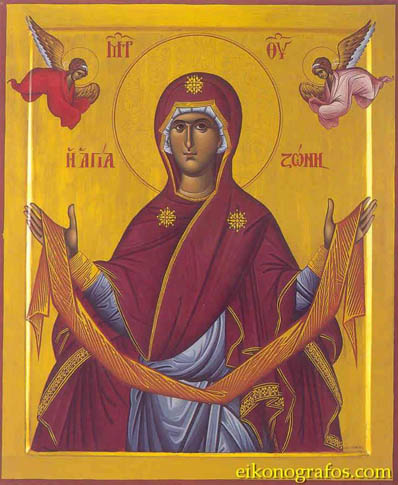

Church of Mary of Blachernae and the Maphorion
One of the most famous churches in Constantinople was St. Mary of Blachernae. It was a giant columned basilica close to the Golden Horn in the far northwestern corner of the city . It was built in the fifth century and survived for 1,000 years being rebuilt at least once in its history. It was beautifully decorated and housed a famous icon of the Theotokos and the robe of the Virgin called the maphorion.
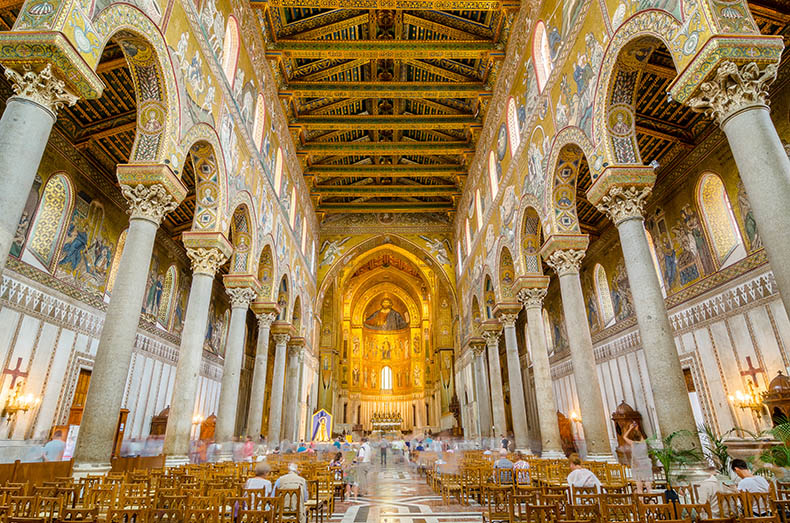 Above is an example of a three-aisled Byzantine basilica with a flat wood gilded roof and mosaics. This would have been very similar to the church as it was rebuilt in 11th century. It is missing an ambo and chancel screen.
Above is an example of a three-aisled Byzantine basilica with a flat wood gilded roof and mosaics. This would have been very similar to the church as it was rebuilt in 11th century. It is missing an ambo and chancel screen.
During the 5th century there was a increase in veneration of the Virgin Mary who was named the Theotokos - Godbearer - at the Third Ecumenical Council held at Ephesus in 431. The elevation of Mary's status was strongly supported by women in general and members of the Imperial family specifically. It was an early feminist movement. Nestorius, the Bishop of Antioch who was deeply involved in the controversy over the Divinity of Christ, was scandalized by the 'excessive worship and near-deification of Mary in the city, bolstered by the Imperial court". He had a head-on collision with Pulcheria who was the most prominent promoter of the cult of Mary in Constantinople. Many of the most famous icon types of the Virgin and Child appear at the same time. Some of them ended up being attributed to the Evangelist Luke, who was believed to have been a painter and created these portraits from life. New churches were created in Constantinople to celebrate the Virgin's new status. The most famous was the great basilica Church of St. Mary of Blachernae - Panagia Blacherniotissa - which was traditionally built by Empress Pulcheria and her husband Marcian in 450.
Pulcheria was the second (and oldest surviving) child of the Emperor Arcadius. Her brother was the future Emperor Theodosius II. She was extremely religious and took private vows of chastity. Her younger brother was a worthless non-entity and Pulcheria ruled in his place. She married Marcian formally but maintained her vows privately. The 6th century historian Procopius is our source for the news that the columns were Parian in the remodeling of the church by Justinian, but he seems to have been little interested in marble types so he probably means the columns were marble and white. The quarries on the island of Paros were still working in the 6th century.The Church of Saint Mary of Blachernae was built with a double row of either Parian or Proconnesian marble columns with a gallery. The choice of Parian marble would have been unusual, Proconnesian marble was less expensive and came from closer quarries. There were many Proconnesian columns already in stock and waiting for projects to use them. At the time most of the forums and public monuments were being built from it. Whichever marble was used it was white and that color was chosen to express the immaculate virginity of Mary the Theotokos. The church would have looked like the Church of the Acheiropoietos, another fifth century church in Thessaloniki which is pictured below. It was built outside the walls of the city near a wellspring that became associated with cures brought through the intervention of the Theotokos. The church was very popular with the court and the common people and became a destination of pilgrimage. A small palace was built south of the church where the Imperial family could bathe in water from the holy spring and rest after liturgy. It had a number of chambers that were richly decorated with marble.
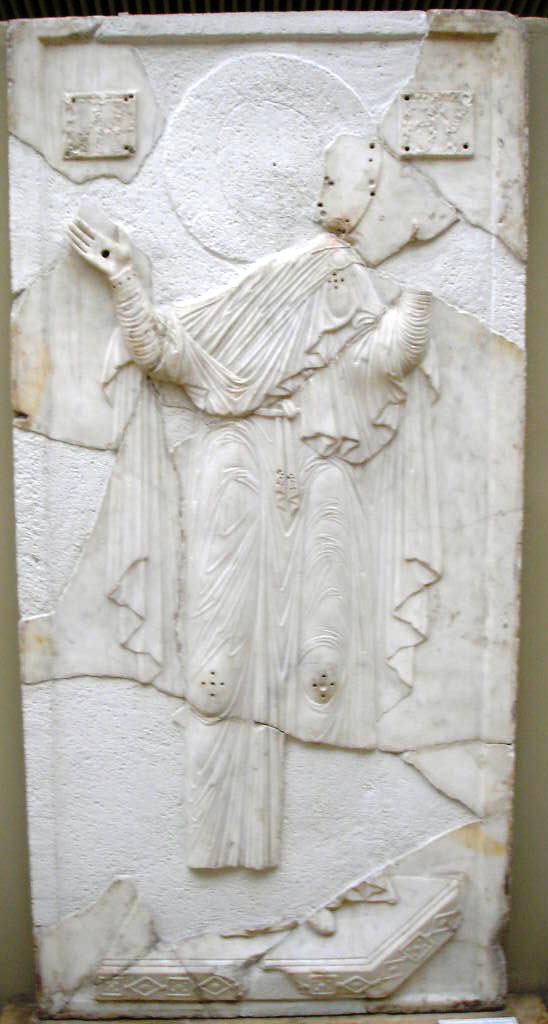 There were two famous icons named Blacherniotissa. One was a painted icon that was displayed in the new church and another one made of carved marble in the shrine of the Soros. The painted icon showed the Theotokos holding the Christ child in her arms and the marble one depicted her alone, standing with her arms outstretched. The marble icon was widely copied and there are a number of surviving examples of it. The painted icon was reproduced in millions of copies. Icons of the Blacherniotissa could show her in many poses. The attribution was associated with the spiritual manifestation of the power of the Virgin in this location and could be expressed in different icons. You can tell which icons are Blacherniotissa because they are labeled with it.
There were two famous icons named Blacherniotissa. One was a painted icon that was displayed in the new church and another one made of carved marble in the shrine of the Soros. The painted icon showed the Theotokos holding the Christ child in her arms and the marble one depicted her alone, standing with her arms outstretched. The marble icon was widely copied and there are a number of surviving examples of it. The painted icon was reproduced in millions of copies. Icons of the Blacherniotissa could show her in many poses. The attribution was associated with the spiritual manifestation of the power of the Virgin in this location and could be expressed in different icons. You can tell which icons are Blacherniotissa because they are labeled with it.
You can see a copy of the beautiful marble icon on the right. It is a great shame the face has been lost. This one was found smashed and thrown into the foundations of the Church of Saint George of the Mangana. The holes in the hands are probably not for water, they possibly held golden stars or rosettes. This example does not have any marks of water damage which would be there if it had been used as a fountain. This icon was widely copied - even by local artists - in faraway locations. None were are beautiful as this one. One of the best replicas in in San Marco in Venice, which was carved in local marble, so it cannot have been brought from Constantinople.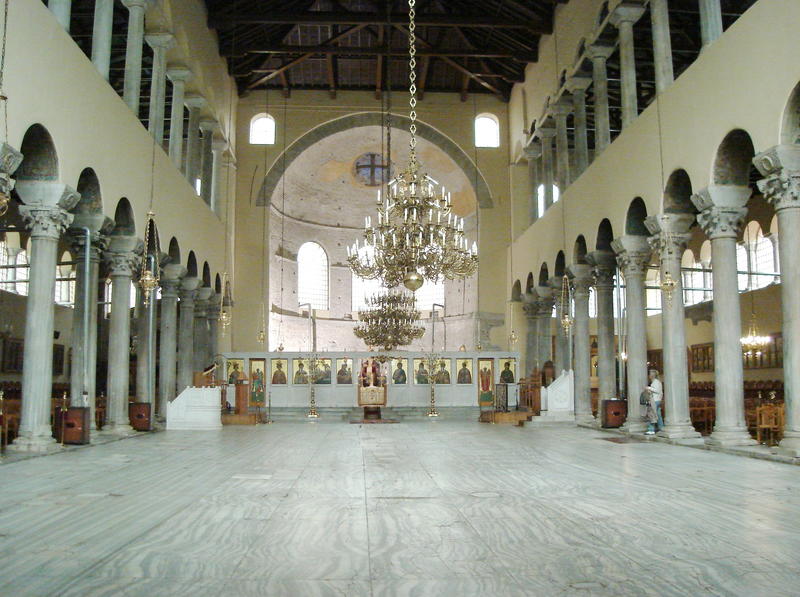
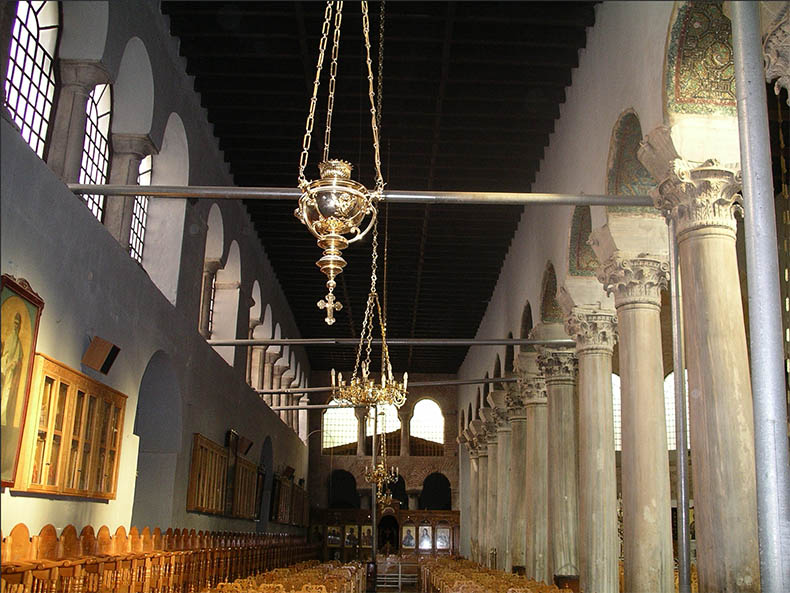
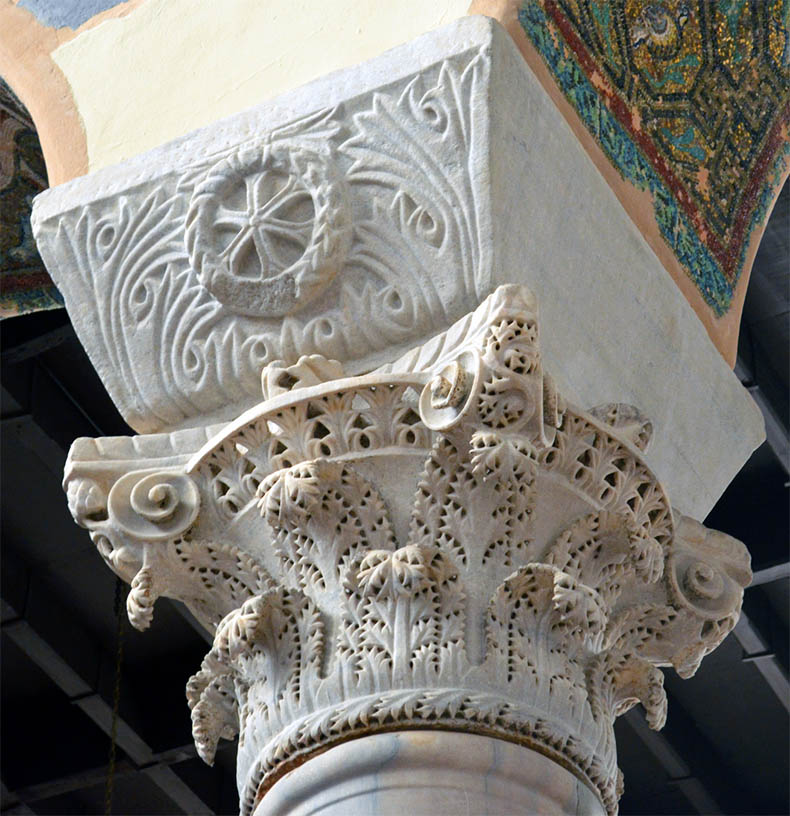
Above are three pictures of the Church of the Acheiropoietos and a close-up of its splendid capitals in Thessaloniki, Greece. The church is dedicated to an image of the Theotokos that was supposed to have been made without human hands. The church is almost the exact size as the Blachernae Church of the Theotokos and dates from the same time. The fact that this is just the north aisle of the basilica shows the enormous scale of the church. The capitals would have have been almost identical to these which were all carved in a Constantinople workshop. The columns here are Proconnesian.
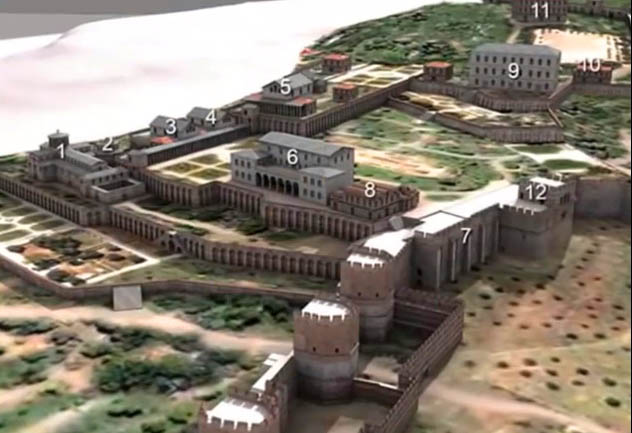 Above is a reconstruction of the Blachernae from Byzantium 1200, looking up the hill to the north. 1) Church of the Theotokos (incorrectly restored with a dome); 2) Holy Soros; 3) Anastasiakos Hall; 4) Danubius Hall; 6) Palace of Alexios I; 7) Prison of Anemas; 8) Baths of Alexios I; 9) Palace of Bertha-Irene; 11) Palace of Manuel I; 12) Balcony & Tower Chambers of Isaac II Angelus.
Above is a reconstruction of the Blachernae from Byzantium 1200, looking up the hill to the north. 1) Church of the Theotokos (incorrectly restored with a dome); 2) Holy Soros; 3) Anastasiakos Hall; 4) Danubius Hall; 6) Palace of Alexios I; 7) Prison of Anemas; 8) Baths of Alexios I; 9) Palace of Bertha-Irene; 11) Palace of Manuel I; 12) Balcony & Tower Chambers of Isaac II Angelus.
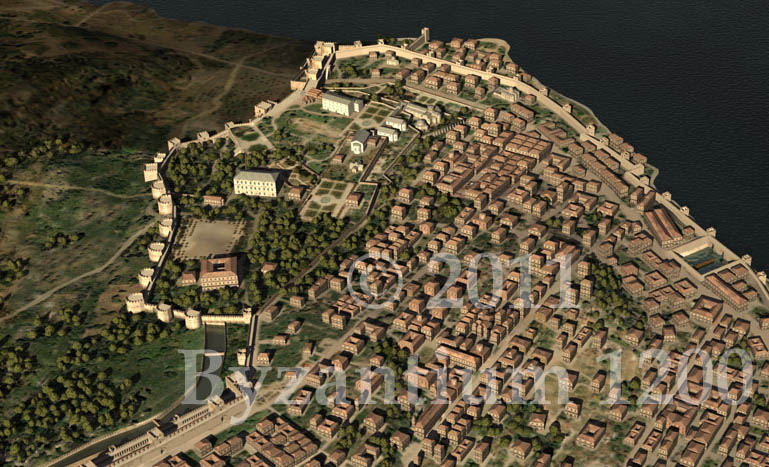 Above is another reconstruction of the Blachernae from Byzantium 1200 looking south towards the Golden Horn. At the very top is the private Imperial harbor. The white building near the top is the Palace of Alexios I; to the east of it is the church of the Theotokos; below them to the left is the gray Palace of Bertha-Irene and further down, near the great courtyard, is the palace complex of Manuel I colored brown. The Palace of Manuel I was actually the biggest of the three. At the top on the left, shaded out, is the location of the Palace of the Philopation and its hunting grounds. Alexios I kept his lions just outside the walls here.
Above is another reconstruction of the Blachernae from Byzantium 1200 looking south towards the Golden Horn. At the very top is the private Imperial harbor. The white building near the top is the Palace of Alexios I; to the east of it is the church of the Theotokos; below them to the left is the gray Palace of Bertha-Irene and further down, near the great courtyard, is the palace complex of Manuel I colored brown. The Palace of Manuel I was actually the biggest of the three. At the top on the left, shaded out, is the location of the Palace of the Philopation and its hunting grounds. Alexios I kept his lions just outside the walls here.
Pulcheria built three churches in Constantinople dedicated to the Theotokos in Constantinople; the Monastery of the Hodegetria, the Church of Mary of Blachernae, and the Chalkoprateia - of the bronze workers - a small church near Hagia Sophia that was built on land that had been bought from the Jews and had been a synagogue. In building these churches and bringing important relics of Mary to the city Pulcheria's objective was to create spiritual dwelling places for the Theotokos where the people could come and venerate her. She got away with some excessive demands of the church because she was the Augusta; her image was displayed above the altar, her robe was used as an altar cloth and she was allowed to receive communion within the sanctuary as is she was a priest. There was always a danger in Byzantium that respect or honors offered to a ruler could be confused with the worship of God since they took place in churches and chapels. Essentially most court ceremonies (except those secular ones that took place in the Hippodrome and the Forum of Constantine) followed the same rituals as religious ones. Some emperors, like Manuel I Comnenus, went too far in identifying himself with Christ, who he believed spoke to him directly. Manuel believed he shared in Christ's own nature in a unique and personal way because of his position as a sacred anointed emperor and the "Champion of Orthodoxy", the state religion.
It helps to understand how the church in the fifth century was defining the role of Mary in a new way without making her a goddess and extending worship to her that belonged to God alone. There would be no fourth member of the Trinity. They were pushing veneration for Mary to its limit with flowery hymns like this one. The hymn writer Proclus - who became patriarch in 434 - was commissioned to write this litany to her for the virginity festival that Pulcheria sponsored in 428, he also wrote secular Imperial panegyrics to her. The hymn is a religious panegyric to the Theotokos that is within the boundaries of orthodox Christology. Pulcheria would have known the limits of how far this could go:
"For this reason we now call Mary Virgin Theotokos.
She is the unstained treasure of Virginity
She is the paradise of the second Adam.
She is the workshop of the union of natures, the festival of the covenant of salvation.
She is the bridal chamber in which the Logos wedded all flesh.
She is the living bramble bush of nature, which the fire of divine labor pains do not burn up,
She is the true relieving cloud, the producer of him in the body, higher above the Cherubim.
She is the purest fleece of the heavenly rain from which the shepherd clothed the sheep.
Mary, the servant, and mother, virgin and heaven, The only bridge from God to humanity,
The awe-inspiring loom of the oikoumene, in which the robe of unity was woven inexpressibly."
In a Christmas oration Proclus took the Magnificat of the Gospel of Luke and expanded upon it. It is in Luke's Gospel that we meet Mary. It is no surprise that Luke was believed to be the painter of so many portraits of Mary and Jesus from real life. In contrast Paul never mentions Mary by name, only that Christ was born of a woman:
"Hail full of grace, unreaped soil of heavenly grain.
Hail full of grace, undeceitful Virgin Mother of the true vine, Hail full of grace, unfailing net of the immutable Godhead.
Hail full of grace, wide open field of the undivided nature, Hail full of grace, oh unstained bearer, bride of the bereaved world.
Hail full of grace, the weaver of the crown, which was not braided by hand, and was made for creation,
Hail full of grace, the house of holy fire,
Hail full of grace, you are the return for those who fled the world.
Hail full of grace, You are the undepletable treasury of the world.
Hail full of grace, The joy from you, Holy Virgin, is infinite, Hail full of grace, You are adorned with many virtues, you are the torch-bearing light, and the inextinguishable light brighter than the sun."
The church forbade the chanting of anything except the psalms in church, Proclus's new verses were delivered within the context of a sermon, not the liturgy, using the form of an Imperial poem addressed to an empress. The use of the word "hail" is how one would greet an emperor in Roman times.
It's interesting that the advocacy of Pulcheria and her female relatives for Mary can be seen as a feminist movement. They were able to assert their own opinions and direct religious policy because they held real power. The male members of the dynasty were weak and disengaged, even stupid. They abdicated authority to her willingly. Besides being well-educated and an Imperial princess, she had a strong and assertive personality. When she was attacked by opponents - like Nestorius - she fought back. Nestorius accused her of many things; he she was not the chaste virgin she claimed to be - but had six or more lovers that he could identify by name.
Pulcheria's Monastery of the Hodegetria was originally built for monks who 'indicated the way' to God. It later became associated completely with increasingly famous icon of Theotokos 'of the Hodegetrion Monastery' and the icon absorbed the original name of it and gave it a new meaning as a director to Christ as the "Hodegetria icon". In this meaning the icon became famous all over the Christian world. There was both a shrine of the icon and a church at the monastery that continued to operate right up to the fall of the city in 1453. The Augusta Pulcheria and other female members of the Imperial family personally draped their own veils over the icon to protect it. This started a tradition of veiling the icon which continued for its entire 1,000 year life. Later veils were made of translucent linen and silk that was embroidered with gold thread and bordered with pearls and gemstones. The icon had been taken close to the walls of the city during the Ottoman siege of 1453 to protect it. When the city fell one of the first churches to be sacked and desecrated was the one housing the icon, which was robbed of its precious settings, split in four pieces and burned.
The Chalkoprateia was also a basilica and later was run by the clergy of Hagia Sophia. It had a famous school in the 12th century. Another item of the Virgin's clothing was kept here.
The Blachernae was the church most dear to the Constantinopolitans; its fame spread from Crete to Cherson in the Crimea, where other churches were named “Blachernae” in its honor. Pulcheria's sister-in-law, Eudocia brought the first icon "painted by Saint Luke" from Jerusalem to Constantinople and gave it to Pulcheria who in turn placed it in the Hodegetria.
The Holy Maphorion of the Virgin
In recent years it has been argued by Cyril Mango that the association of Pulcheria with these Marian shrines is a later invention and that the famous shrine of the Holy Soros, which housed the maphorion of the Virgin which came to Constantinople in 460 from Nazareth was the 5th century church. This was during the reign of Leo I and his wife Verina, who were depicted in the apse of the Soros. Mango believes the huge church - 68 feet wide and 146 feet long - was built by Justin I (517-528). We know that Justin II made changes to the church, possibly adding a shallow transept or apses to the aisles. At this time the plain white columns may have been replaced with green ones of Verde Antico. In any case it was a major rebuilding - almost a replacement. Thus, according to Mango, Blachernae began as a holy site with the building of the Holy Soros which was vastly expanded by the church built by Justin I. This does not explain the fact the church is mentioned in texts prior to Justin's reign. It appears Mango is wrong.
The Emperor Heraklios extended the city walls to protect the church and the suburb that had been built around it shortly after the Avar siege of 626, meaning the church had been defenseless for the first 200 years of its existence. The silver and gold in the church, including a silver box containing the maphorion, was removed in advance of the attack, which was proven unnecessary because the church survived the Avars, who lifted their siege and vanished. The survival of the church - amidst a murderous barbarian army which destroyed everything in its path - was attributed to miraculous intervention of the Theotokos who spared her own church as a sign of her power and grace.
In 619 Theophylact of Simocatta describes his viewing of the maphorion. He also tells the story that the maphorion was brought to Blachernae by Galbios and Kandidos - recent converts from Arianism - from a small town in Galilee by subterfuge and established a house church on their estate in Blachernae dedicated to it. One night they stayed at the home of a very old Jewish woman. She was quite dignified and ascetic. They discovered that she possessed the Virgin’s shroud and kept it in a small chest. According to the legend, the old woman was a descendant of Mary’s, and the robe had been passed down in her family for generations. After stealing the robe they brought it back home to Constantinople where they end up giving it to Verina:
'We went to the church of the Mother of God which the Byzantines, who hold it in awe, call Blachernae. This shrine stands in high honor with the faithful and is the object of great devotion on the part of the city. It is said that the clothing of the Virgin Mary (whom we Romans correctly - and alone - call “the God-bearer”) is deposited there in a gold-encrusted casket."
The story is told that gold casket was opened in 860 by the Patriarch Sergios. At first he were disappointed to see the cloth was frayed and badly decayed with time. Then he discovered the cloth was wrapped around a purple wool shawl which was perfectly preserved. Its preservation was attributed to the fact it had been close to Christ while He was in her womb.
The Emperor Romanus I Lecapenos took the maphorion into battle with him. Earlier even the Iconoclastic Emperor Theophilos had it carried on the walls of the city to protect it. Alexios I took it on campaign against the Patzinaks when his daughter Anna Comnena tells us he had to hide it in some bushes. Since it was used by Alexios I it obviously survived the fire of 1069. The fate of the maphorion is unknown. After the Fourth Crusade it might have been cut up and sent to churches in the west. Russian pilgrims who visited the church in 1389 say the maphorion was stored in an iron-bound box near the altar that was sealed with the Imperial seal and they could not see it or venerate it. If the maphorion was not rescued from the church during the 1434 fire it was lost in the flames. Since it was in a heavy stone box it would have been hard to carry. There are no later mentions of it in historical texts.
Decoration of the Church - Weekly Miracles - the Holy Shroud
The renowned mosaics of the church included the Feasts of the Church, images of prophets, martyrs, hierarchs, and saints in addition also representations of peacocks, eagles and other birds in the nave. The decoration of birds and animals dated from iconoclastic times. There was a beautiful ambo with a solea leading to chancel screen, just like Hagia Sophia. The church had a huge clergy that was reduced to 74 by Heraklios, who was hard pressed to raise money for his wars in Persia and had to melt down some of the treasures of Hagia Sophia to finance them.
In 753 the Emperor Constantine V held sessions of the seventh Iconoclastic church council in the Church of the Blachernae, which had been stripped of images of Christ, Mary and the saints and replaced frescoes of the life of Christ with "trees, birds and beasts of various sorts, leaves of ivy, cranes, jackdaws, and peacocks, in festoons". Constantine denied the intercession of the Virgin and the invocation of saints and stripped the Virgin of the title of Theotokos. The first victim of iconoclasm was the Blachernae monk Peter Calybites, "Hermit of the Cell". Andrew went to the palace, denounced Constantine to his face, and was brutally beaten to death as punishment. His body was rescued by his sisters who rescued it before it was thrown into the sea. Constantine was Byzantium's Henry VIII, thousands of victims followed Peter and all of the churches were despoiled.
On March 11, 843 iconoclasm ended - the restoration of the Holy Images - called the Triumph of Orthodoxy - has been celebrated every year since as a major feast of the church. The first image to be restored was the great image of Christ over the Chalke Gate of the Sacred Palace which was painted by the artist Lazarus. It was fitting that this icon of Christ was the first one to go back up, since it was here that the Iconoclastic emperors started their destruction of images with this one. Lazarus went on to create some of the mosaics of Hagia Sophia, including the Virgin and Child in the apse.
A number of famous icons were associated with the church, including the Theotokos Blachernitissa icon known as the Great Panagia. It is possible that important portable icons of the Theotokos and Christ were rescued by iconodule refugees, both monks and lay people who took them out of the city to protect them. There were many nearby monasteries in which to hide them. The imperial government was probably glad to see them go without public scenes of destruction of art works that were supposed to have been painted by Saint Luke himself! There was also the marble relief that was in the Soros that soon reappeared in Blachernae back in its old location.
Once again the painted icon was paraded around the city and up on the walls - along with the maphorion - to protect it during sieges. The icon was associated with the royal court of early Russ as the "Great Protector of Princes".
Sometime in the middle of the 9th century the icon of the Theotokos Blachernitissa, also called "Our Lady of the Sign", became the source of a weekly miracle at the church. At Friday Vespers a translucent veil lifted mysteriously revealing the icon. This was one of the greatest theatrical presentations in Constantinople that combined all the senses. In the ceremony the veil lifted under its own power and lowered the following day on its own accord. The ceremony was accentuated by the light of flickering candles and aromatic oil lamps; the scent of wax was combined with fragrant incense which moved in clouds through the church. At the same time there were the echos of chanting singers in unearthly sounding angelic voices. This miracle was a demonstration of the personal protection of the Theotokos over the city and its people. The miracle did not always occur. It ended in 1204 when the icon was lost or stolen. The miracle was very popular in the 11th and 12th centuries and was attended by people from all classes. The miracle would have echoed the opening and closing of the curtains of the sanctuary during the liturgy when the miracle of the transformation of bread and wine occurred. The Byzantine historian Michel Psellos describes what he saw, people felt the spirit of God moved over the icon and animated the movement of the veil:
“as if some breath of air gently moved it. What happens is unbelievable... and an overt descent of the Holy Spirit. The form of the handmaiden of the Lord changes simultaneously with what is accomplished, as it receives her animate visitation, thereby visibly signaling the invisible.”
The miraculous descent of the Holy Spirit upon the church had been happening for centuries independently of the icon with ceremonies attached to it. In the 9th century, after the restoration of icons, the miracle became focused on the image as long as it was there. The church was on two levels with a colonnaded gallery, you could witness the miracle from the main floor of the church and from above. The church was huge and could accommodate thousands of people who wanted to see it.
Icons of the Great Panagia show the Theotokos lifting a veil in her hands depicting the actual miracle. People who had witnessed the miracle would have wanted to have copies of the icon to bring the memory and power of the miracle into their homes. It would have been easy to touch these copies with the actual veil that was placed over the original. Since the miracle was believed to have been done by the Holy Spirit which moved throughout the church, when it occurred your own body and clothing would have been imbued with a vestige of it. Thus one could bring it home with you. The miracle itself was recorded in icons all over the Orthodox world. This icon was replicated long after the Blachernitissa disappeared, and miracle ended and the church itself was lost.
Today it is easy to disparage belief in miracles like these. We assume there was someone pulling on a cord somewhere that was in on the "miracle" and somehow justified the fraud being played on people. The Byzantines did not suffer from our own modern cynicism, they sincerely believed in they were done by divine intervention. Obviously, they lived in a world that was very different than our own.
We had a weeping icon in a Russian Orthodox (ROCA) in Christ of the Hills outside Austin in Blanco a few years ago. The weeping started in 1985. They even had billboards advertising the weeping icon and signs directing people to their monastery. It was covered on TV. They said the Theotokos was crying because of the sins of the world and abortions. I went to see it for myself with some friends several times. I doubted the tears were real because the icon was painted in acrylic paints - acrylic paint creates a solid barrier that can't sweat or shed tears. At the same time I could not believe it was a fraud. I gave them icons, money and food. My friends did the same. One of them, an Irish Catholic women, saw the boy-novices and said there was something weird going on there. It turned out two of the monks - on orders from the abbot - were applying the tears and leaving cotton swabs inside the kiot that were supposed to have been catching the tears. They would give these to donors. They did all of this prior to visitors being admitted into the chapel where the icon was. They even added the scent of roses to the roses as another part of the miracle. Most of the monks were in on it, Abbot Boniface was formerly Samuel Green a real estate man. He founded the monastery in 1981 and somehow got ROCOR to accept him and the monastery under their jurisdiction from 1991-1999. I still cannot understand how they could stand before God everyday and pray when they were living a lie and deceiving the public about the icon. They were raising an enormous amount of money off of the weeping icon. Once they started the fraud they had to keep it going and brought new monks into it. Eventually the abbot and several of the monks were arrested for child abuse, they had been molesting those boys who were novices. The monastery was raided and shut down in 2006 - 21 years of fraud came to an end. Samuel Green committed suicide in his trailer at the monastery in 2007. Since then I have never believed in weeping icons. I also understand how people can be drawn into these things because they want to believe miracles are real.
The French clergy that took over the church may have carried the icon off to their own country or even sold it. The icon, which was one of the most esteemed in the city, it was probably hung in a baldacchino with columns and a canopy of silver-gilt. It would have been easy to remove and return the icon from this setting. Besides the precious covering of the icon itself and it's jeweled veils, its baldacchino would have been covered with gilt-silver, enamels, pearls and other gemstones. The first crusaders entering the church would have immediately stripped it of its precious decoration, probably damaging the icon itself.
The miracle was regularly attended by the Imperial family until 1204. The people of Constantinople and were notoriously superstitious and would have viewed the non-occurrence of the miracle with alarm and panic. Since it was a weekly event if the miracle the next week everything would have been OK.
There were other relics in the church including the bodies of Saint Patapius and Saint Anastasia that were kept in different chapels.Besides the maphorion of the Virgin which was stored in the Holy Soros the church also on occasion hosted some of the Passion relics. After being processed through the city the icon of the Theotokos Hodegetria was brought to the palace of Blachernae from Good Friday to Easter Sunday. The famous Holy Shroud - the Sidona - was shown on a special apparatus that unrolled it showing the face to the public. Robert of Clari describes the ceremony which he saw during the Fourth Crusade:
“There was ... [a church] called My lady Saint Mary of Blachernae where was kept the syndoine in which Our Lord had been wrapped, which stood up straight every Friday so that the features of Our Lord could be plainly seen there. And no-one, either Greek or French, ever knew what became of this syndoine after the city was taken,”
Robert of Clari is the only one who has described this miracle involving the Holy Shroud. Its mysterious disappearance could mean it was taken by a French bishop or soldier during the sack of the city. It did not fall into the hands of the leaders of the crusade because it was not kept with the other relics of the Passion that were in the Church of the Pharos when the city fell that were captured intact together and in their original precious reliquaries. The great icon of the Panagia vanished without a trace at the same time.
The Emperor Romanos III Argyros had the capitals of the church and the ceiling beams gilded in 1031. During the Latin occupation the church had a Roman Catholic staff of French canons. The Latin emperors would attend Mass there when they were resident in Blachernae.
In Palaelogian times the ceremony of Imperial weddings, which was always a private court function, was moved to the Church of the Theotokos from chapels in the Great Palace. It also became the site where important state commitments and treaties were sworn.
There were other churches in the Blachernae quarter including Saint Nicholas of Blachernae which lay between the Theotokos church and the land walls, probably very near the Tower of Saint Nicholas tower. This church was said to have been originally built by Justinian. It also had a holy well which still exists. No traces of the church have been found.
The Church is Rebuilt - the Fourth Crusade - Civil Wars - Attack by Genoa
Later emperors expanded the defenses of Blachernae and strengthened them. The Blachernae was always considered the weakest part of the land walls and the emperors became more concerned about its vulnerabilities as they built more palaces here. There was a special harbor built near the church for the Imperial family who often visited the Holy Soros and church by boat from the Great Palace.
The Church of the Theotokos burned down to its foundations in 1069 during the reign of the Emperor Romanos IV Diogenes. The fire must have started in wooden roof of the church. In the reconstruction the church was rebuilt with columns of green Verde Antico marble (like Hagia Sophia) that had white marble bases and capitals. They must have been salvaged from the ruins, recut, polished and used again. This would have reduced their size a little or cut down on the length of the aisles if some of the columns broken and unsalvageable. The replacement church was a 3-aisled basilica with galleries and a with a gilded wood ceiling. It had an ambo in the center of the church and a columned sanctuary barrier. The plan followed the footprint of the original structure. There was no dome or transept. Romanos had taken the famous icon of the Virgin from the church on a military campaign which saved it from the fire, it returned and the weekly miracle began again. The walls were covered with previous marble revetment and a new set of mosaics was put up in the church above it.
During the initial assault of Fourth Crusade in July 1203 the Blachernae was bombarded by catapults and the palaces were damaged. Emperor Alexios IV brought the crusaders into Blachernae to negotiate with them. In desperation he offered to turn over the palaces to his western friends if they guaranteed him protection during any attack on the city. His duplicity was discovered by his subjects, he was overthrown and strangled to death. The new Emperor Alexios V Mourtzouphlos moved into Blachernae. In August, the crusaders set fire to nearby homes along the Golden Horn and the fire spread from here, burning most of the city.
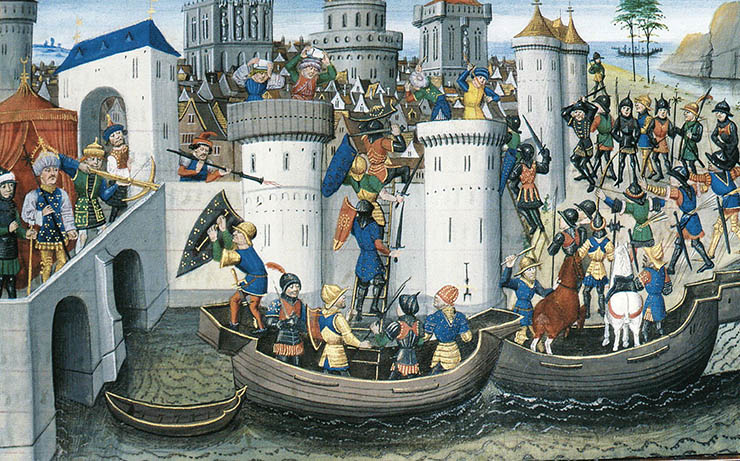 On April 13, 1204 the crusaders broke through the fortifications here using a battering ram. The Imperial guard who was left in the palace surrendered to Henry, the brother of Count Baldwin of Flanders, on the promise that none of the people in the palace would be harmed. The promise, once made, was not honored. He immediately set his own guard over the palace to ensure the treasures in the palace would all be his. Most of the servants would have brought their families into the palace for protection during the assault. All of people within the palace who could not ransom themselves were forcibly ejected from it and were immediately set upon by other crusaders waiting for them in the courtyard. Servants and courtiers were stripped and searched for any valuables they had on them.
On April 13, 1204 the crusaders broke through the fortifications here using a battering ram. The Imperial guard who was left in the palace surrendered to Henry, the brother of Count Baldwin of Flanders, on the promise that none of the people in the palace would be harmed. The promise, once made, was not honored. He immediately set his own guard over the palace to ensure the treasures in the palace would all be his. Most of the servants would have brought their families into the palace for protection during the assault. All of people within the palace who could not ransom themselves were forcibly ejected from it and were immediately set upon by other crusaders waiting for them in the courtyard. Servants and courtiers were stripped and searched for any valuables they had on them.
Being so close to their point of entry, the Theotokos Church was the first to be looted and striped of its treasures. It was full of people from the neighborhood who mistakenly hoped they would be safe here. It was incomprehensible that to them that their own fellow Christians could want to harm and rob them. They didn't know that the crusader bishops had authorized their extermination because they said they said the Byzantines were not truly Christians but heretics. Looting was also authorized for the same reason. Children were not to be spared. The Bishops joined into the killing and looting themselves. Just in case, some Latin clergy hired other crusaders to do the dirty work for them, so they could avoid potential sin.
Once they were in the church the crusaders pulled the silver covers from the icons turning them into gaming boards, destroyed the gilt-silver ciborium and altar and carried off the sacred vessels used in the liturgy and used them as drinking cups. Many of the crusaders had visited the church before the attack and knew where everything was. Common people and clergy were tortured in order to make them confess where things had been hidden. Mobs of soldiers and camp followers swarmed over the churches and palaces looting and pillaging. Every woman who could be grabbed was raped, including young girls and nuns. The Latins collected immense piles of silks, pulling curtains from windows and rummaging through chests of Imperial clothing looking for valuables. Desiring the palaces as their own residences the leaders of the crusade intervened to stop the destruction of the palaces and set guards over them. Even though they initially lusted over them, the crusaders living in the palaces like barbarians. After one palace had been ruined by them they simply moved to another one and repeated the same destruction there. They rounded up former Imperial servants and tried to force them into service, but they couldn't pay them and had to let them go. They forced out the Greek Orthodox clergy and installed French clergy, who were incapable of running the churches and chapels. The job was simply too big for the few clerics who the Pope sent to Constantinople. The Venetian and the French clerics fought over who would control which churches and monasteries. The Venetians got the prize of Hagia Sophia. The churches crumbled around them and the Latin Emperors were to poor to support their maintenance or pay their salaries. The Catholic clergy sold off stuff from their churches to raise money. Unfortunately during their occupation the Latins failed to repair all the damage they had done to the district in the assault. Many historic and beautiful buildings that might have been restored were lost through this misuse and willful neglect.
In 1217 the stripping of lead and copper from churches in occupied Constantinople was denounced by the Latin Legate from the Pope in Rome, Pelagius. This did not stop the new Latin Patriarch in Hagia Sophia from doing just that on two occasions - in 1221 and 1222.
During the Latin occupation, around 1234, the Nicean Emperor John III Vatatzes donated money for the upkeep of the Church of the Theotokas, despite the fact it had been taken over by Latin clergy. There had been a great earthquake in Constantinople on March 11, 1231 and the donation may be related to needed repairs there after the quake. The Latins also removed valuable things like the gold-enameled templon of the south Church of the Pantokrator, which was decorated with semi-precious stone and rare marble. Its parts where shipped to Venice. The Venetians, who occupied the complex of Comnenian churches and monastery buildings, replaced it with a new templon with white marble bits taken from the now ruined church of Saint Polyeuktos. The Venetians dispatched shiploads of stuff from Saint Polyeuktos to decorate the inside and outside of San Marco.
On June 21, 1302 14 Venetian ships commanded by Belletto Giustinian sailed into the Golden Horn accompanied by 7 pirate ships which they had picked up ion the way in Crete and Negroponte. They anchored opposite the Blachernae palace and their men went ashore to do as much damage as they could. They set fire to bales of straw that they found on the shore in front of the walls. The resulting flames could be seen from the city and the nearby palaces where the emperor was resident. Too late Andronikos II, never a forceful or decisive leader, realized that without ships he was absolutely powerless to retaliate. A bridge of boats was suggested to be built across the Golden Horn from Imperial troops could attack the Venetians. Andronikos thought that this would do more harm than good. When night fell the pirate ships attacked the nearby Princes Islands in the Sea of Marmora. They were crowded with refugees from the Turks in Asia Minor. Such of them as could not afford a ransom were murdered. Others were brought within sight of the Blachernae and tortured before the emperor's eyes with the connivance of the Venetians. The emperor protested to their commander Giustinian, sending him 4000 hyperpyra as ransom money for the surviving refugees.
The Black Death struck Constantinople in 1347 carrying off 50% or more of the population. One western chronicler says it struck down eight-ninths of its citizens. The Turks seem to have been immune to the Black Death and it resulting depopulation of the countryside opened up Thrace to their incursions. The plague took place during civil wars among the aristocracy were were conducted by mercenary armies right in the streets of the city. There was fighting around the palaces of the Blachernae by foreign troops who were brought into the city by its own nobles in disputes over who should control the dwindling empire. Empress Anne of Savoy was surrounded in the old palace Manuel I built for his German wife Bertha by John Cantacuzene and 1000 men (mostly mercenaries and even Turks) who had broken into the city and stormed their way into the two courtyards that surrounded the Blachernae palaces. During the fighting the tower-gate to the main courtyard was destroyed. Anne was forced to negotiate with the rebels to save the throne for her son John Paleologos, who was 15 years old at the time. Anne had to agree to allow John Cantucuzene to reign as co-emperor with him. She ended up a prisoner in her own palace and had to pawn the crown jewels and remove silver and jewels from icons in order to save herself and her son from ruin. These seeming endless conflicts provided no benefit or even security. they only added to the depression and demoralization of the people who were taxed even more to finance these follies. This was just a year after the dome and eastern arch had collapsed in Hagia Sophia! Money that had been raised for its restoration was diverted to pay for mercenaries. Another special tax was imposed on the citizens of the city to pay to complete the mosaics.
In August 1348 the Latin Genoese, who controlled Galata, brazenly sailed along the coast of the Golden Horn, burning ships along the way to force the Byzantines to grant them more trade rights. They attacked the Church of the Theotokos and the monastery of Christ the Savior with catapults, but the people of city saw the stones slide harmlessly off of their lead roofs. They saw it as a miraculous act of the Virgin of the Blachernae, who had intervened once more to save the city. The area around the church was still densely populated and the church was popular with the merchants and artisans that lived there.
The Last Days of the Church of Mary of the Blachernae
In 1403 the church was described by Ruy González de Clavijo as follows:
"This church of St Mary was formerly the chapel of the Imperial Palace [of Blachernae]. It consists, in the main-building of three naves, [or rather a nave and two aisles] the nave being far greater in width and height than the aisles. These last are low built, and have galleries [forming a second floor], from which you may overlook the nave. The roofing of both the aisles and the nave is seen to be supported on great pillars of green jasper, whose bases and capitals are formed by blocks of white marble, very skillfully sculptured with figures and designs. The walls in the aisles, up to half their height under the ceiling, are faced with slabs of many colored jasper, the same being very artistically sculptured in scroll-work of a beautiful design. The ceiling of the central nave is most richly wrought with squared beams of wood joisted together, the whole ceiling of squared beams and joists being thickly gilded in fine gold. Further, though this church is elsewhere in some places out of repair, the gilding and workmanship of the ceiling aforesaid are as fresh and as beautifully preserved as though the same had but recently been completed. In the nave stands a very fine altar, also a pulpit most richly wrought: the whole edifice indeed is splendidly built, rich, and very costly; and the roof outside is entirely covered with a sheeting of lead."
Visitors to Blachernae used a road that ran parallel to the long side of the church and the disrepair of the exterior would have been easy to see. Perhaps at this point the atrium of the church was ruined or there were cracks in the exterior walls. One would have entered the church through the atrium and a portico and narthex.
In 1394 the first great Ottoman siege and blockade of the city began which lasted on and off for eight years. It began when Sultan Bayazid sent a huge army to utterly destroy everything outside the walls of the city, all the farms, homes, churches and monasteries along with the vineyards and orchards - everything was burned. All of this was done with the people of Constantinople watching from the city walls. The city was locked up tight, no one could enter or leave it. After this demonstration of terror the Sultan trusted the city would surrender without a fight once they saw the fate that awaited them. Groups of Turks could be seen peering into the city from the surrounding hills with covetous eyes. The Sultan was actually choosing which buildings in the city would be turned over to specific commanders. He announced that he would take Hagia Sophia and make it his own personal palace to house his harem. It looked really bad, but the people didn't loose their nerve and organized their defense.
The fields outside the walls which usually fed it could not be cultivated, no one could get to them. The city was saved from immediate starvation by what foodstuffs could be grown within the walls and boats that managed to sneak into the city. In preparation for the siege great stores of food had been already established within the walls by the government and church authorities. Most of the stuff grown within the walls were vegetables and fruits along with what the vineyards within the walls could produce. It was not enough to last for long. Soon there were shortages of corn, oil and wine. The Venetians managed to get a shipment of grain into Constantinople by sea. Wooden beams had to be removed from buildings to bake bread. The operators of small boats got better and better with time in getting supplies into the city, but the needs of the city were enormous. After a temporary respite in the blockade due to a relief army that had been sent to save the city, which failed enroute and was destroyed the Sultan the blockage turned into a full scale siege. The people, who were starving and pended in within the walls. Many fled the city. The church was in the direct line of fire, the portico faced the direction of giant catapults that were throwing boulders and pots of fire into the Blachernae. The low-lying church would have been an obvious target with its enormous white lead roof pointing east into the city. Had the portico been ruined the nave and sanctuary would have still functioned. A bushel of grain cost 20 gold pieces, but no one had any gold to buy it with. The siege ended when the Ottomans were attacked in the East by the Mongols and their army was utterly destroyed by Timur at the battle of Ankara in 1402. Their amazing deliverance from the Turks was attributed to the intervention of the Theotokos who had come to the rescue of the city once more.
Whether the church was damaged during the blockade or suffered from neglect during those dark years, there was no money to repair the church after it. This seems to me the most logical explanation for the state of the building.
In 1422, the Ottoman Sultan Murad besieged the city again with over 100,00 troops. There would soon be tens of thousands of new Christian slaves to serve them. Sultan Murad built a huge rampart of earth behind the walls crossing from the Sea of Marmora to the Golden Horn. The troops lobbed fire and stones into the city using catapults, in a scary aerial attack on the city. The Turkish camp was full of slave traders and dervishes who had come to collect the booty and slaves that had been promised to them when the city fell. An Ottoman seer, a descendant of the Prophet, the imam Seid-Bokhari predicted the city would fall on August 24th. Thankfully he was wrong. On that same day the Islamic soldiers panicked and abandoned the siege, burning their camp behind them. When stories like this were heard by the people understood what there fate would be if Constantinople fell to an Islamic army. During the siege both men and woman fought heroically on the walls of the city to defend their homes and families from enslavement. They came to truly believe only God himself - His personal intervention - could save them if the people failed. The burning of the Church of the Theotokos must have made them despair even of the Virgin's help, which had saved the city so many times before. There was lots of bad news to come, in 1430 Thessalonica fell to the Turks and its centuries-old churches, like the ancient shrine of Saint Demetrios, were quickly turned into mosques.
So it comes as no surprise that the church caught fire and burned 11 years after the siege on January 29, 1434 when the damaged portico was hit by lightening in a great storm. The fire was seen all over the city and was one of the last great disasters to strike Christian Constantinople. Crowds would have watched the fire spread throughout the great church with horror. The church was located in one of the most heavily populated parts of the city, very near a great market along the shires of the Golden Horn. People must have wondered what terrible sin had been committed to earn the ruin of such a beautiful building and a church that was beloved by everyone. Parts of the building collapsed into the flames sending up huge clouds of embers over the city. The smell of the blaze and smoke would have drifted along the streets and billowed into the rooms of the nearby palaces. We can imagine that the emperor and his family watched the fire from upper story balconies, helpless to stop it and worried that the flames might spread to the nearby Palace of Alexios I. The ruins smoldered for a very long time and the ruins of the church weren't cleared away.
The loss of the church during the reign of John VIII, who was the next-to-last emperor, was a huge blow to the morale of the city. One can imagine people who saw the fire rushed to save relics and artistic treasures; darting in and out of the burning church with icons, books and precious sacred vessels used in the liturgy. After the fire the authorities must have ordered a survey to access the possibility of rebuilding and must regretted the foolishness of putting off the repairs for so long. There must have been many such loses due to fire and collapse of historic buildings in those last years, which would have been very depressing. The church remained a burnt out shell until 1547 when the sad ruins were no longer to be seen. The stone and marble were probably carted away for the building of the new Süleymaniye Mosque which was built by Sinan in 1550. Many of remaining columns in the city - like the giant 17 surviving columns of the Hippodrome - were harvested from Byzantine sites all over Istanbul for that project.
John VIII began negotiations to end the schism of the churches. His goal was to raise help for the empire from the pope and the western kings of European Christendom to repel the Turks, who it was expected would soon arrive outside the walls of the city. After long negotiations over the proposed terms of reunion by Byzantine envoys, John himself with a huge entourage of church and state officials and scholars, boarded papal ships to Italy to attend the Council of Ferrara in 1437. He had to borrow the money to cover the costs of the mission. The Byzantines made a powerful impression on the Italians for their splendid retinue, sophisticated manners and classical education. The Council was a success in concluding a union of the churches, but the promised military campaign was a failure and the people of Constantinople rejected the union their rulers had agreed to without their consent.
With such troubles it is understandable that repairs to historic churches and palaces had to be put on hold. The survival of Constantinople was hanging the balance. What money there was had to be spent on repairing the walls and cleaning out the moat. The church had been in a state of disrepair for awhile, it badly needed a new roof. Leaks must have been damaging those wonderful mosaics for a while. Since the loss of the Pontic forests - and the sea routes to deliver them - Byzantium no longer had access to the long straight timbers that basilicas required. This church was especially huge. The decay of the church must have been hugely embarrassing for the last emperors - it was a highly visual sign of the decline of the city and their poverty. The fire was not blamed on the lack of repairs - the responsibility was laid on gay men who, it was said, met there. God had destroyed the church because of their sins, in 1437 Pero Tafur wrote about it, he was there just three years after the fire and would have seen the ruins:
"There was a church at Constantinople, not so large as St. Sophia, but, as they say, much richer, which St. Helena built, desiring greatly to show her power. At the entrance were certain arches which were very dark, and they say that people were found there frequently committing the offence of sodomy, and one day a thunderbolt fell from Heaven and set fire to the church, and not one of those who was surprised in that sin was spared. The church they called Blacharyerna, and it is to-day so burnt that it cannot be repaired."
An alternate story was told that the fire was started by accident by some young nobles who were chasing pet pigeons which had flown into the church. For some reason Pero Tafur thought the population of Constantinople was wallowing in sin. He must have seen loose sexual morays there. Since ancient times prostitution had been widespread and being a seaport Constantinople who have been known as a place of licentious behavior. Tafur would have seen amazing things on the streets of the city, including gay men and transvestites. He describes the people of the city, " The inhabitants are not well clad, but sad and poor, showing the hardship of their lot which is, however, not so bad as they deserve, for they are a vicious people, steeped in sin". For hundreds of years visitors to Constantinople commented on the crime in the streets and the sinful nature of the Greeks. Foreigners must have been the target of thieves, pick-pockets and con artists, who complained that nothing was done to prevent criminal activity in the city and complaints to the city authorities was ignored. It was possible to go the head of the Varangian Guard at the Blachernae and file a special complaint which could be passed on to the Emperor for action.
The holy well still exists and a small church was built here centuries later by the Greek population of Istanbul. It is possible the fire spread to other nearby buildings, including surviving parts of the Blachernae palaces. This area was still densely populated in the last centuries of Byzantium and a new commercial food market developed along the waterfront. The port was still active until the fall of the city.

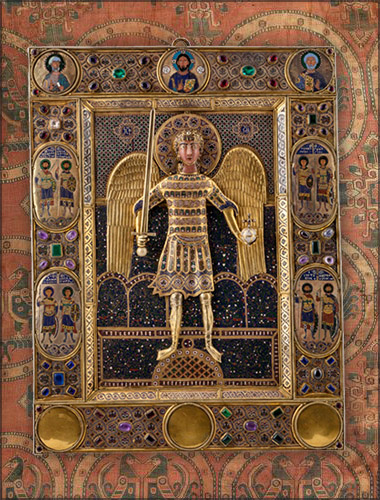

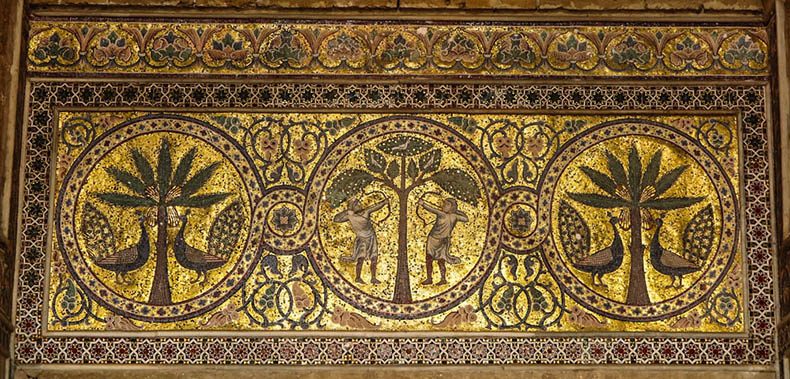

 click here for icons of christ
click here for icons of christ click here for icons of the theotokos
click here for icons of the theotokos click here for icons of angels
click here for icons of angels click here for icons of saints
click here for icons of saints








